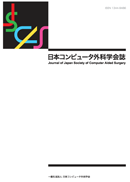
- Issue 4 Pages 177-
- Issue 3 Pages 107-
- Issue 2 Pages 55-
- Issue 1 Pages 3-
- |<
- <
- 1
- >
- >|
-
Yasuyuki Seto2019 Volume 21 Issue 1 Pages 3
Published: 2019
Released on J-STAGE: April 09, 2019
JOURNAL FREE ACCESSDownload PDF (109K)
-
Keisuke Osawa, Ryu Nakadate, Jumpei Arata, Shinya Onogi, Tomohiko Akah ...2019 Volume 21 Issue 1 Pages 5-11
Published: 2019
Released on J-STAGE: April 09, 2019
JOURNAL FREE ACCESSIncidence rate of colon cancer is the highest among all cancers in Japan while the rate is still being on an upward trend. It is generally known that the colon cancer diagnosed in its early stage, is permanently curable by a minimally invasive manner. The first choice of diagnosis for colon cancer is colonoscopy while the inspection requires a great skill, because the manipulation of endoscope surrounded by the layer of soft intestinal tissues is highly cumbersome (e. g. large intestines only stretches and the tip of endoscope does not advance even the proximal end of endoscope is pushed hard by the inspector). In order to solve this problem, we propose a self-propelled colonoscope robot with a conical worm gear mechanism. The drive force is provided from the motor outside the patient body by a torque tube to a conical worm gear to turn four spur gears arranged in a radial fashion at the tip. Thus the robot can move forward and backward in intestine. The notable feature of the mechanism is that the conical worm gear lets the four spur gears moved in a radial fashion, thus the mechanism provides sufficient propelling force even in the intestines with different radii. A prototype mechanism was developed as a proof-of-concept model by using a 3D printer and driven by a motor. The preliminary experiments on a simulated intestine with different radii (ranging from 30 to 50 mm) and in-vitro tissues showed the promising results.
View full abstractDownload PDF (995K) -
Kojiro Mekata, Hotaka Takizawa, Jun Matsubayashi, Tomoyuki Takigawa, K ...2019 Volume 21 Issue 1 Pages 12-17
Published: 2019
Released on J-STAGE: April 09, 2019
JOURNAL FREE ACCESSWe attempt to elucidate swallowing disorders on the basis of a relation between swallowing and the motion of cervical spines. In our previous paper, we proposed a tracking method of cervical vertebral bodies and spinous processes in videofluorography images by use of template matching technique. In the present paper, these cervical structures are tracked by using the previous method for two seconds during swallowing, and it is shown that there are differences in their movement characteristics between a cervical spine disorder group and a normal group. In addition, we propose a discrimination method of cervical spine disorders based on the analysis of movement characteristics. The area under the receiver operating characteristic curve was 0.746 in twenty-six samples.
View full abstractDownload PDF (978K)
-
2019 Volume 21 Issue 1 Pages 29-36
Published: 2019
Released on J-STAGE: April 09, 2019
JOURNAL FREE ACCESSDownload PDF (543K) -
2019 Volume 21 Issue 1 Pages 50
Published: 2019
Released on J-STAGE: April 09, 2019
JOURNAL FREE ACCESSDownload PDF (138K)
- |<
- <
- 1
- >
- >|